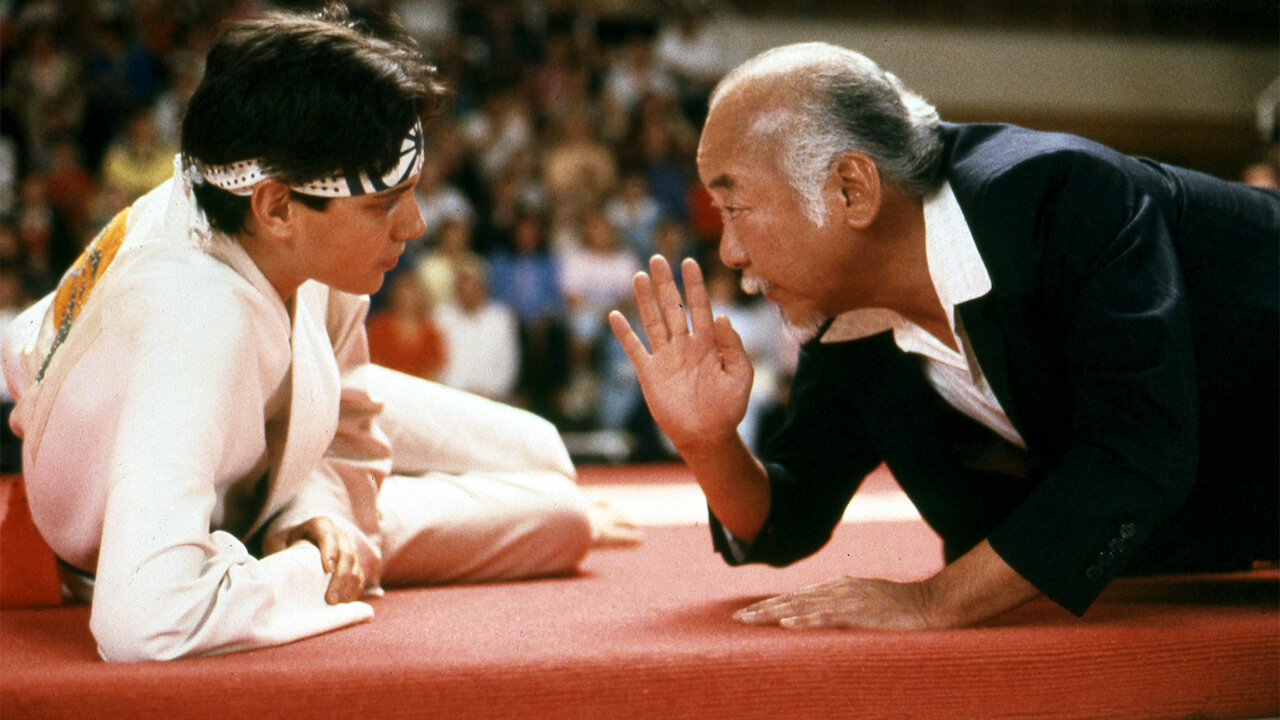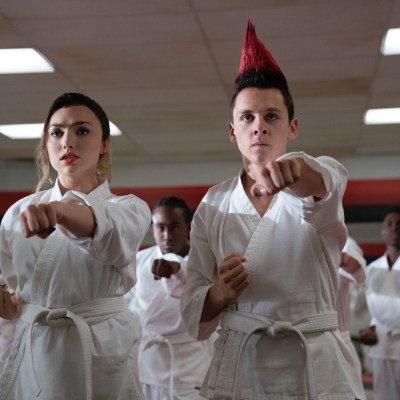When it comes to martial arts films, The Karate Kid was a game changer when it came out in 1984. Its lasting cultural impact was a landmark advancement for the western understanding of the martial arts. But was it a genuine representation of Karate?
Den of Geek consulted Dr. Hermann Bayer, an expert authority on Okinawan Karate and the author of the upcoming book Analysis of Genuine Karate―Misconceptions, Origin, Development, and True Purpose. Dr. Bayer remembers firsthand how The Karate Kid stimulated the Karate boom in the mid-eighties because he was a practicing Karateka then. But as a martial scholar, he’s pragmatic about his opinions.
“First and foremost, we have to bear in mind that we are talking about a movie, not about a documentation or a piece of research,” says Bayer. “This means that we need to concede that fascinating viewers by something pretty, amazing, or spectacular to look at is more important than authenticity.”
The Year That The Karate Kid Premiered
When we reflect upon the original, we must remind ourselves that the landscape of martial arts films in the west was vastly different in 1984. There just weren’t that many martial arts movies in western pop culture back then.
Bruce Lee’s Enter the Dragon came out over a decade before The Karate Kid, and tragically, Lee didn’t live to see it succeed. Many B-movies coat-tailed on Enter the Dragon‘s success, especially in the subgenres of Bruceploitation and Blaxploitation. This comprised the bulk of martial arts for western audiences. Beyond the imported niches of Hong Kong Kung Fu and Japanese samurai movies, there just weren’t that many other martial arts films available. And those were limited to showings in second- and third-run theaters or midnight “Kung Fu Theater” TV broadcasts. Consequently, the genre was considered low-brow entertainment with minimal impact on the box office.
When The Karate Kid debuted, most of today’s martial arts superstars had no Hollywood presence. Despite starring in dozens of Hong Kong films, Jackie Chan had only led one Hollywood production by that point. That was Battle Creek Brawl, made by the same filmmakers who did Enter the Dragon, however it under-performed and was deemed a failure. His other Hollywood credits in 1984 included a cameo in the sequel ensemble comedy The Cannonball Run II. With only three minor Hollywood appearances, he was still virtually unknown to the Western audience.
Chuck Norris was more prominent having starred in more than a half dozen B-action flicks by then. His 1984 entry was Missing in Action in which Jean-Claude Van Damme had an uncredited role. JCVD didn’t grab any limelight until four years after The Karate Kid, when he starred in his breakout lead role for Bloodsport. Jet Li was only on his second film that year, Kids From Shaolin, but that wasn’t shown outside of Chinatowns in the U.S. It would be another 14 years after The Karate Kid before Jet made his first Hollywood appearance as the villain in Lethal Weapon 4.
The Karate Kid changed the way martial arts films were perceived. It demonstrated that the martial arts genre could deliver wholesome family entertainment, as well as good box office returns. It ranked fifth among the highest grossing films of 1984, behind Beverly Hills Cop, Ghostbusters, Indiana Jones and the Temple of Doom, and Gremlins. The Karate Kid was the sleeper hit of the year, and it made Daniel LaRusso (Ralph Macchio) and Mr. Miyagi (Pat Morita) into crane-kicking icons.
The Limitations of the Karate Kid Trilogy
The Karate Kid was a Hollywood adaptation of a common plot device of Kung Fu movies – the training trope. Many of Jackie Chan’s late seventies films were “martial training” stories. Those narratives can be distilled down to three acts as seen in The Karate Kid: the hero suffers an injustice — like the murder of his family (or in Daniel’s case, just getting bullied) — then the hero finds a quirky master who uses obscure, almost non-nonsensical training methods, and finally the hero, armed with these hard-earned skills, takes revenge.
Jackie’s groundbreaking 1978 Snake in the Eagle’s Shadow is a perfect example of this. That was a turning point for Jackie, the launch of his unique style of comedy Kung Fu, back when he was in his physical prime. In that same year, the Kung Fu grindhouse Shaw Brothers studios delivered the timeless classic film The 36th Chamber of Shaolin, which is a perfect example of the same formula. “Martial training” stories are even retold in animated films like Mulan and Kung Fu Panda. The Karate Kid just had the ingenuity to set it at West Valley High School in San Fernando, California.
Today, Daniel-san is enjoying a revitalization through Netflix’s hit series Cobra Kai. Packed with more easter eggs that an April bunny basket, Cobra Kai has been rectifying flaws from the original films with a subtle, yet effective elegance. Despite its time-honored success, the original films fell under tremendous scrutiny from genuine Karatekas who were quick to point out inaccuracies. Frankly, for such a flagship film of the martial arts genre, the martial arts weren’t that good. The main cast of the original film had little or no martial arts background. Kreese (Martin Kove) was the only cast member who studied Karate prior to the films.
Part of this adds to the charm. Despite being the All Valley Karate Champ twice in a row, Daniel is a newbie to the art. In fact, the original trilogy happens in a little over a year. The Karate Kid takes place in 1984. The Karate Kid III, despite premiering in 1989, depicts events at the following All Valley Karate Championships. Daniel goes from zero to hero in an alarmingly short time.
How could Daniel genuinely master Karate with so little training time? Is “wax on, wax off” deck sanding and fence painting truly that effective? Of course not. If it were, the MMA cage would be dominated by car washers, carpenters, and house painters. That’s the magic of movies. Movie martial arts are no more realistic than movie car chases.
This still begs the question – how much of Miyagi’s weird training really works?
“Whole floor. Right circle, left circle.”
Traditional martial arts training can take many forms, and the spirit of Mr. Miyagi’s esoteric lessons isn’t too far off the mark. Although few practitioners today carry water up mountains like the Shaolin monks, mundane chores like cleaning and repairing are still implemented in training within a traditional Dojo. Frankly, the repetitive nature of martial arts practice is boring so any way to invigorate enthusiasm is welcome. And the efficiency of multi-tasking is always appreciated, even in modern strip mall Dojos.
A common training ritual is cleaning the floor before class. This is extremely important because most Dojos practice barefoot. Many old school Dojos require that students push damp rags across the floor with their hands in a low crouch. As anyone who has done it knows, this is harder than it looks and serves as an excellent warm-up exercise. When the Dojo needs repairs, students pitch in where they can because a good Dojo fosters community that way, and variations on training emerge within those tasks akin to Miyagi’s painting and sanding. And if there’s a Dojo fundraising carwash, you know there will be plenty of “wax on, wax off” practice.
But beyond the waxing, sanding, and painting, how real is Miyagi-Do?
“Only root Karate come from Miyagi.”
There are two styles of martial arts represented in The Karate Kid, Okinawan Karate and Korean Tang Soo Do. Kreese’s Karate is Tang Soo Do mostly because the choreographer for the original films was Grandmaster Pat E. Johnson, a leading proponent of that style. Although most likely the product of coincidence, it fit Kreese’s character perfectly. Many U.S. soldiers who served in Korea brought Tang Soo Do back to the states when they returned, just like Kreese, including Johnson and his martial comrade, Chuck Norris.
In Season 3 of Cobra Kai, Kreese’s backstory confirms what martial arts fans have always suspected – that his style of Karate is in fact, Tang Soo Do. Calling it “Karate” was not inaccurate. Few Americans know Tang Soo Do, so even today, some schools market themselves as “Korean Karate.” Tang Soo Do is a predecessor of Taekwondo. Taekwondo is the other Asian martial art in the Olympics alongside Judo, but this is soon to change.
Read more
Miyagi-Do is derived from a branch of Karate known as of Goju-Ryu. Writer Robert Mark Kamen had learned some Goju-Ryu which inspired him to create Mr. Miyagi. He even poached the name of the founder of Goju-Ryu, Chojun Miyagi, and adapted the history to fit the Miyagi family history for The Karate Kid II where they travel to Okinawa. Goju means “hard-soft.”
“Karate legend Miyagi Chojun gave the name ‘hard-soft’ to the style in the mid-1930s,” explains Bayer.
Bayer finds the contrast between Miyagi’s and Kreese’s philosophies more intriguing than their difference of styles. “I see the first movie of the trilogy as the most important in terms of establishing the two contrasting mindsets of Mr. Miyagi’s ‘Karate approach to life in general’ and John Kreese’s ‘No mercy’ combat-specific attitude. However, both mindsets are essential to and part of genuine Karate.” Bayer claims that fighting in genuine Karate is exclusively reserved for life-threatening situations. “Karateka never start a fight; they always end a fight―and to end a fight ‘no mercy’ is essential.”
The All Valley Karate Championships and the Olympics
The most unrealistic story element in The Karate Kid is the All Valley Karate Championships. Beyond the controversy about whether Daniel-san’s crane kick win was illegal, Karate tournaments didn’t have the level of production value in the eighties depicted in the movie. Even today, they seldom get that elaborate. A hexagonal ring is hard to make out of the square puzzle mats typically used for local tournaments nowadays. And that spectacular tournament table backdrop was way beyond the budget of tournament promoters. However, Karate will soon be showcased on the global stage, replete with a grand pageantry far beyond what the All Valley Championships imagined.
The Tokyo Olympics will introduce Karate as one of the five new sports in 2021. This will be divided into two categories: Kata, which is a solo form recital akin to gymnastics floor routines but with kicks and punches instead of leaps and flips, and Kumite, which is sparring. Here, Dr. Bayer draws an important distinction between authentic Karate and sport. It’s a critical distinction for what plays out in The Karate Kid. “As long as any kind of rules are implemented, combat changes into some kind of game,” says Bayer. “Life-protecting fighting is pure violence, pitiless full-power action, and has no place in a sport setting.”
Here also is where Bayer sees Kreese’s villainy. A symptom of his wartime PTSD, Kreese is unable to make the distinction between self-defense and sport. “The ‘No Mercy’ combat approach in competition and sports is inexcusably misplaced and represents an ‘Americanized’ misconception of Karate, characterized by ‘winning at all costs’ in combination with the importance of fancy uniforms, of ranks, and of other attributes in an attention-seeking culture.”
According to Bayer, this is also where the authenticity of Miyagi’s contrasting Karate approach shines. “This is the exact opposite of Mr. Miyagi’s humble Karate-Do mindset, where ranks, belts, and other visible signs of competency are irrelevant. His answer to the question what belt he wears was ‘Canvas. JC Penny. Three ninety-eight. You like?’ In spite of its lethality, the purpose of authentic Karate training is not the use of violence, it is gaining self-control, especially in situations loaded with threats and aggression, and where blood pressure and adrenaline levels are off the chart.”
Despite this separation of killing art and sport, Bayer still sees the role of sport Karate as extremely important, and he can’t wait to see what happens at the Olympics. “Sports Karate canalizes aggression into fun and competition activities, and its training practices are perfect for physical education, for health and fitness purposes. Under a responsible coach, students grow mentally and are guided towards positive values―reflected in modern physical education learning outcomes and their according training designs.”
“Karate here. Karate here. Karate never here.”
Despite its martial shortcomings, The Karate Kid succeeds in revealing the heart of Karate. The hardships Daniel endures, his loyalty to his sensei, Miyagi’s humility, and the distinctions between the street fights and the championships all play out with an uncommon sincerity, and perhaps that is the secret of its longevity. Even if Miyagi-Do is entirely by Kamen’s design, it’s a clever homage to Okinawan Karate. And even in the martial world, that’s hard to find.
“Authentic Okinawan Karate’s genuine purpose was exclusively self-protection and the protection of someone’s life,” says Bayer. “This genuine Okinawan Karate is hardly to be found in today’s worldwide Karate practice.”
The Karate Kid trilogy is streaming on Netflix now.


